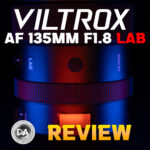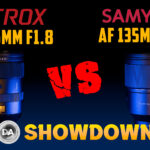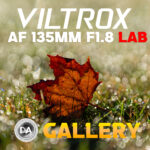
Viltrox AF 40mm F2.5 E-mount Review
Earlier this year I did one of my first ever Nikon Z-mount reviews, and it was of a brand new Viltrox lens that released first to Nikon – the Viltrox AF 40mm F2.5. I found it to be quite an impressive little lens for the money in my review, and noted in that review that we would almost certainly be seeing that lens in other mounts like Sony E-mount in the near future. Fast forward three months and that time has arrived, and the Sony E-mount version (which we’ll call the 40mm F2.5E in this review) is now available. The 40mm F2.5E offers a “normal” angle of view on full frame cameras and a slightly faster maximum aperture than equivalent zooms covering this focal length. But probably most attractive to potential buyers will be the budget price of just $158 USD, as while Nikon has an attractive 40mm F2 Z lens that is reasonably priced at under $300, the closest comparison first party lens on Sony is the $600 Sony 40mm F2.5 G (a lens I did appreciate in my review, but that’s a HUGE price difference!) I suspect a lot of people will appreciate a budget alternative, so we’ll explore whether this is worth considering in today’s review. You can watch the video review or just read on in the text review.
Follow Me @ YouTube | Patreon | Instagram | Facebook | DA Merchandise | Flickr | 500px | X
Thanks to Viltrox for sending me a review copy of this lens. As always, this is a completely independent review. *The tests and most of the photos that I share as a part of my review cycle have been done with the Sony a7RV and the Sony Alpha 1.
__________________________________________________________________________________________________
- Viltrox AF 14mm F4 (full frame)
- Viltrox AF 20mm F2.8 (full frame)
- Viltrox AF 40mm F2.5 (full frame)
- Viltrox AF 50mm F2 (full frame)
- Viltrox AF 9mm F2.8 (APS-C)
- Viltrox AF 15mm F1.7 (APS-C)
- Viltrox AF 25mm F1.7 (APS-C)
- Viltrox AF 35mm F1.7 (APS-C)
- Viltrox AF 56mm F1.7 (APS-C)
_______________________________________________________________________________________________
The Viltrox AF 40mm F2.5E is a compact, lightweight, and tough little lens with relatively few features. But it also is capable of producing beautiful photos, delivering great autofocus, and being an extremely easy lens to throw into a bag and bring along.

When you combine this with a budget price, you have a lens that is going to interest a lot of people as a an inexpensive “normal” lens.

So is this a lens that you should consider? Keep reading to find out.
This review is a mix of elements from my previous review (on Nikon) though updated with all of the specific
Sony details and many new photos taken on Sony.
Viltrox AF 40mm F2.5E Build and Handling
As noted, the build here is basic, but that’s to be expected at this kind of price point. At least everything is built around a metal lens mount.

There’s also the ubiquitous Viltrox feature there – a USB-C port to enable firmware updates.

This has been a great move by Viltrox, as it has enabled them to keep their lenses current and to allow for some improvement to function (like autofocus). The ability to easily update firmware assures that lenses will stay compatible in the future, which is obviously very important.
The E-mount version of the lens is identical to the Z-mount version but with one exception; the Z mount version has a much wide flange near the lens mount to accommodate the much larger diameter (55mm) of the Z-mount vs the E-mount (which is 46mm). This does change the overall diameter of the lens a bit since this is actually the widest point of the lens. You can see that the shape is a bit different in the comparison of the two here.

The primary objective for Viltrox is to keep things small and lightweight. And in that metric they have been very successful. The 40mm F2.5E is 65mm (2.5″) in diameter and right under 60mm (2.2″) in length. It has a common 52mm front filter thread and weighs just 167g (5.9oz). That’s 13g lighter than the Z mount version. The weight here is so negligible that you never need think twice about throwing it into the bag for a hike or a trip.

I used this on some of the larger Sony cameras, though frankly there isn’t a radical size difference between many of Sony’s models. It would be a great pairing on the compact A7C series of cameras, though, making for a truly lightweight kit.

The size is virtually identical to the 20mm F2.8. The two lens hoods are identical, and I suspect that if one were to compare lenses for identical mounts they would be identical.


If we look inside, we can see that there are seven aperture blades that aren’t particularly rounded. You will see that aperture shape at times. And, as is sometimes the case with Viltrox lenses, I don’t find the aperture shape perfectly symmetrical, either.

The only thing on the lens barrel is the manual focus ring, but fortunately that is pretty well executed. It’s nice and wide, has good feel, and offers good manual focus precision without visible steps. Nothing really to complain about there, particularly on such an inexpensive lens.

There is a very slim lens hood included that bayonets into place but without as much precision and confidence as I would like. It doesn’t feel like it really “clicks” into place and locks in the right position. A lens pouch is also included. The pouch doesn’t add a lot of protection value, but, like the hood, at least it is included. There are many more expensive lenses that include neither a pouch or a hood.

Viltrox lenses have traditionally had a fairly poor minimum focus distance and maximum magnification standard, but fortunately that is starting to change. The Viltrox AF 40mm F2.5Z has a minimum focus distance of 34cm and a respectable maximum magnification of 0.14x.

Up close performance is only okay at F2.5. You’ll need to stop down a bit to get maximum sharpness and contrast.

This inexpensive lens does not have weather sealing, though that’s obviously not expected in such an inexpensive lens. This is a pretty basic lens, but it doesn’t feel “cheap” or “plasticky”. It is primarily made of plastics, but they are good quality, and the lens has a tough, durable feel that seems like it will hold up well for the long haul. I’ve traveled a fair bit with the 20mm F2.8 that is the virtual twin to this lens, and I’ve had zero problems with it. I expect the same here.
Autofocus and Video
The Viltrox AF 40mm F2.5E utilizes a stepping focus motor (STM) that works well, though it isn’t blazingly fast. Focus changes for most things are quick enough for you to forget about autofocus, but every now and then when a major focus change is required you are reminded that this is an autofocus motor that could use a little extra thrust. Fortunately accuracy isn’t a problem; I got consistently well focused results.

I love 40mm for “everyday photography”; the ordinary moments when you just want to have a camera on hand to capture the moments. I like it for family events around a room, but it was also a fun lens to throw into a little bag and take kayaking with my wife and I.

You can see that focus locked in very precisely on Nala’s eye here.


There is a faint clicking sound if you put your ear right next to the lens barrel, but if I held the camera at chest level and racked focus here and there, I couldn’t hear anything. Focus speed was good but not instantaneous in my formal tests.
I didn’t get a chance to shoot any portraits with the Sony E-mount version, but I used the Fuji X-mount version for portraits and it worked fine (and autofocus is much better on Sony than Fuji!)


I did find that focus would sometimes lag behind a moving subject. In this shot of Nala, the focus has fallen to her shoulder rather than on her face.

Switching to video found focus pulls smooth and nicely damped, but not speedy. You could turn the autofocus speed up in camera for focus pulls if desired. What I didn’t see was any hunting or pulsing. Autofocus was solid in terms of confidence. There’s just enough focus breathing for me to notice it, though it isn’t bad.
My “hand test” where I alternately block the camera’s view of my face with my hand and then remove it didn’t go well. The lens wasn’t reactive enough, and so it often hadn’t really switched to focus on my hand by the time I moved it again.
The natural speed is more set for smoothness, so I found that real world focus transitions were fairly smooth and cinematic, but not particularly fast or reactive.
So I give good marks for confidence on the subject and not being jittery, but poor remarks for the reactiveness of the focus motor when needing to move to a new subject. On a positive note, video AF was able to track Nala quite well as she moved rapidly toward me while I backtracked to keep her from reaching me. Here’s a screenshot from that:

The bottom line is that the focus system for both stills and video is smooth and confident, but not incredibly fast. It’s fast enough for most situations, but there might be a few situations where you find yourself wanting more. I was actually more impressed by the AF in the Viltrox AF 56mm F1.7 that I just reviewed.
Image Quality Breakdown
The optical formula is 10 elements in 6 groups, with five of those elements being special elements (including 1 ED, 3 HR, and 1 aspherical element). The MTF chart shows a good (not great) center performance, a dip right past mid-frame, and then a slight recovery in the corners.

I started reviewing Viltrox lenses right at the beginning, and at first I was less than impressed by the optical glass when it came to colors. But Viltrox has really improved their optical glass in the past two years, and now I find colors both neutral and natural looking.

There is a slight amount of LoCA (longitudinal chromatic aberrations), but nothing too severe.

In a real world application, I can see a tiny bit of fringing after the plane of focus on these blossoms, but there’s nothing that will actually be disruptive.


There’s also minimal LaCA (lateral chromatic aberrations) that typically show up along the edges of the frame with high contrast transition points. Here we can see at F8 there there isn’t much to see.

So no significant issues there.
If we move on to vignette and distortion we find good results here. There is next to no distortion (a +1 corrected an almost undetectable amount of barrel distortion) and vignette is less on Sony than what it was on Nikon. I needed only +43 to correct on Sony while it took a +72 to correct on Nikon. I think this has a lot to do with the difference in the mount diameter and flange difference. That’s about 1 1/2 stops of vignette.

We’ll move on to inspecting our test chart. This test has been done on a 61MP Sony a7RV sensor. I use a high end tripod and two second camera delay to ensure vibration doesn’t affect images. Here’s a look at the test chart that we will examine at high magnification:

If we take a look at crops (at 200%) at F2.5 from the center, mid-frame, and lower right corner, we find that center performance is good, but the mid-frame and the corners stand out as being sharper than most budget lenses.



That was reflected in my real world results, which I consistently found pleasingly sharp and with nice amounts of contrast.


Stopping down the 1/3rd stop to F2.8 doesn’t make any kind of radical difference in sharpness or contrast, but it does reduce vignette a bit and increases contrast just enough that the overall looks brighter and slightly snappier.

A more obvious improvement is found from F2.8 to F4, where image quality is now very sharp all across the frame…including the far corners.

There’s a bit more on tap by F5.6, and that makes for very nice landscape results that are richly detailed, have good contrast, and exhibit nice color as well.



Expect the typical diffraction pattern on high resolution cameras where the image is a little softer by F11 and softer still at the minimum aperture of F16, though frankly this isn’t as bad as I often see.

This a degree of sharpness that easily surpasses what you’ll find in a typical “nifty fifty” lens. The maximum of F2.5 isn’t particularly bright, though the lens makes up for it by delivering great sharpness wide open. I zoomed in to 100% magnification on many images and liked what I saw.


Bokeh is a subjective measurement, and I personally find the bokeh from the 40mm F2.5Z a bit of a mixed bag. Probably the most controversial element will be the outlining around specular highlights (sometimes called “bubble bokeh”). Some people love it, some people hate it. Here’s an example:

You can also see that the geometry gets a bit squeezed near the edges of the frame, losing the circular shape.
I don’t mind the look of the outlining of the specular highlights in the image above, but in other situations I found that it created some busyness.

Get a little closer, however, and that bokeh gets softer looking and quite nice.

This shot of a chain-link fence shows both the good and the bad, with a fair bit of outlining in the defocused blackberry vines.

Again, this is a budget optic, and so the bokeh really isn’t bad for the price, but neither is it incredible. I’m more impressed with the lens’ sharpness than its bokeh.
Flare resistance is a bit of a mixed bag. On the plus side, I didn’t see any egregious ghosting patterns either at wide or small apertures.



But you will get some flashing effects when the sun or bright light source is either at the edge of the frame or right out of frame (you can see a bit of this in the first image above). You can see the effect in this image here, though I’ve used it to artistic effect and like the look here.

The Viltrox AF 40mm F2.5E should serve as a nice street lens, general purpose lens, and even a budget portrait lens for when you want a little more of the environment in the shot.

A lens with a maximum aperture of F2.5 is not incredibly bright, but when you consider that a typical kit lens is going to be either F5.6 or F6.3 by 40mm, that means this inexpensive little prime will be giving 200-300% more light gathering potential, making it a much more attractive low light performer than such lenses.

Overall, I would say there is far more good than bad here. You can check out more photos by visiting the image gallery here.
Conclusion
Sony shooters obviously have a wealth of lenses available to them, but even with all of that I’m not sure that there is anything that quite compares to the Viltrox AF 40mm F2.5. Sometimes after having saved a long time to buy a new camera, there isn’t much left over to spend on lenses, and being able to get a quality full frame lens for just $160 USD is fantastic. If you’ve only got a kit lens, for example, getting a brighter lightweight prime lens will open up both better low light performance and more image sharpness as well.

The 40mm F2.5E has a lot of strengths and a very decent (if simple) build for the money. Autofocus speed is adequately fast on Sony, and is also quiet and accurate. The 40mm F2.5E has a number of strengths and no real fatal weaknesses. I suspect that no one would know that you are shooting with inexpensive glass from the images alone.

For the money, this is a great little performer, and the light weight makes it an easy lens to throw into the bag for an alternate perspective or aperture value. I love lenses like this for travel, and this is a great pairing for the smaller a7C series of cameras. There’s no real natural competitor for the 40mm F2.5 E on Sony that costs under $300, making this a great value option for those looking for a “normal” prime.

Pros:
- Compact and lightweight
- Amazing price
- Comes with hood and bag
- Build feels tough rather than plasticky
- USB port for firmware updates
- Autofocus is quiet and accurate
- Excellent sharpness
- Colors look good
- Low distortion
- No fatal optical flaw
- Amazing price to performance ratio
Cons:
- Lens hood doesn’t lock in place well
- Bokeh can get a little busy
_________________________________________________________________________
GEAR USED:
Purchase the Viltrox AF 40mm F2.5 E @ Viltrox | B&H | Adorama | Amazon | Amazon Canada | Amazon UK | Amazon Germany
_________________________________________________________________________
Purchase the Sony a7RV @ B&H Photo | Adorama | Amazon | Camera Canada | Sony Canada | Amazon Canada | Amazon UK | Amazon Germany
__________________________________________________________________
Purchase the Sony a7IV @ B&H Photo | Adorama | Amazon | Camera Canada | Sony Canada | Amazon Canada | Amazon UK | Amazon Germany
_________________________________________________________________
Purchase the Sony Alpha 1 @ Camera Canada | B&H Photo | Adorama | Amazon | Sony Canada | Amazon Canada | Amazon UK | Amazon Germany | Ebay
_________________________________________________________________
Want to support this channel? Use these affiliate links to shop at: B&H Photo | Amazon | Adorama | Camera Canada | Amazon Canada | Amazon UK | Ebay | Make a donation via Paypal
Buy DA Merchandise https://bit.ly/TWIMerch

Keywords: Viltrox, Viltrox AF, Viltrox 40mm, Normal, Full Frame, F2.5, f/2.5, STM, Viltrox AF 40mm F2.5 E, Viltrox 40mm Review, Viltrox AF 40mm F2.5 E Review, Sony a7IV, Sony Alpha 1, Sony a7RV, Review, Hands On, Dustin Abbott, Real World, Comparison, Sharpness, Bokeh, Flare Resistance, Autofocus, Image Quality, Sample Images, Video, Photography, let the light in, weathersealing, #letthelightin, DA











[…] a 40mm F2.5 (my review here). A few years later Viltrox released a 40mm F2.5 on first Sony E-mount (my review here) and then later on Nikon Z mount. I compared that lens with the Nikkor on my Nikon Z8 in this […]